This course is part of the Glass and Glazing Design Academy
Structural Considerations for Storefront Glazing Systems
In some locations, storefront glazing must meet impact resistance requirements, such as those for hurricane-prone areas. This often involves the use of laminated glass and robust framing systems. Likewise, in earthquake-prone areas, storefront systems need to accommodate seismic forces. This may involve additional reinforcement and connections that allow for movement without compromising the integrity of the glazing.
Deflection criteria are specified to prevent excessive movement of the glazing system under load, which can affect performance and appearance. Typically, deflection limits are set to ensure the glazing does not displace excessively, which could cause sealant failure or glass breakage. Also, the design must account for the expansion and contraction of materials due to temperature changes. This can affect the framing and sealants, leading to potential issues with seal integrity and glazing stress.
Installation Guidelines for Storefront Glazing System
For most projects, a storefront glazing system is designed for optimal performance with applications having 4- to 5-foot spacing between vertical mullions with spans generally up to 10 to 12 feet. Manufacturers can provide guidance on exact limitations of glazing products, so it is important to engage the glazing manufacturer early in the design process.
System depth is usually between 4 inches and 6 inches, with system widths, often referred to as “sightlines,” varying between 1 ¾ inches and 2 inches. Due to the nature of the application, storefront glazing systems are not required to span large distances, so overall system depth can be smaller than that of a curtain wall system.
Thermal performance of a storefront glazing system is impacted by the type and style of glazing, installation methods, and thermal bridging. Depending on the climate zone and thermal performance requirements, a storefront system can be either non-thermal or thermally broken. The most typical thermal break method is a small pocket located somewhere in the middle of the extrusion filled with a polyurethane material and mechanically de-bridged to isolate the interior and exterior sections of the extrusion. This is commonly referred to as a “poured and de-bridged” thermal break.
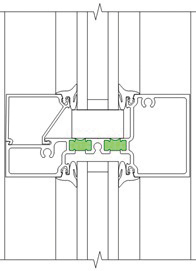
Image courtesy of NGA
Here is an example of a storefront horizontal mullion with dual pour and de-bridge pockets (highlighted in green).

Image courtesy of NGA
Here is an example of a storefront horizontal mullion with mechanically crimped thermal isolating struts (highlighted in green).
Typically, a storefront glazing system is internally drained. This means that any water infiltration is captured in the horizontal member and diverted to the vertical and/or the sub-sill, where it weeps out of the system to the exterior. These systems are dependent on the quality of the internal seals to provide the lower water resistance they are designed to meet.
A storefront glazing is typically designed with three different assembly methods commonly known as screw spline, shear block, and stacking. Screw spline and shear blocking approaches enable glazing contractors to preassemble single units either in a shop environment or directly at the jobsite, while stacking happens on the jobsite. In all three methods, the vertical members typically run continuously while the head, horizontal, and sill members are attached between the verticals.
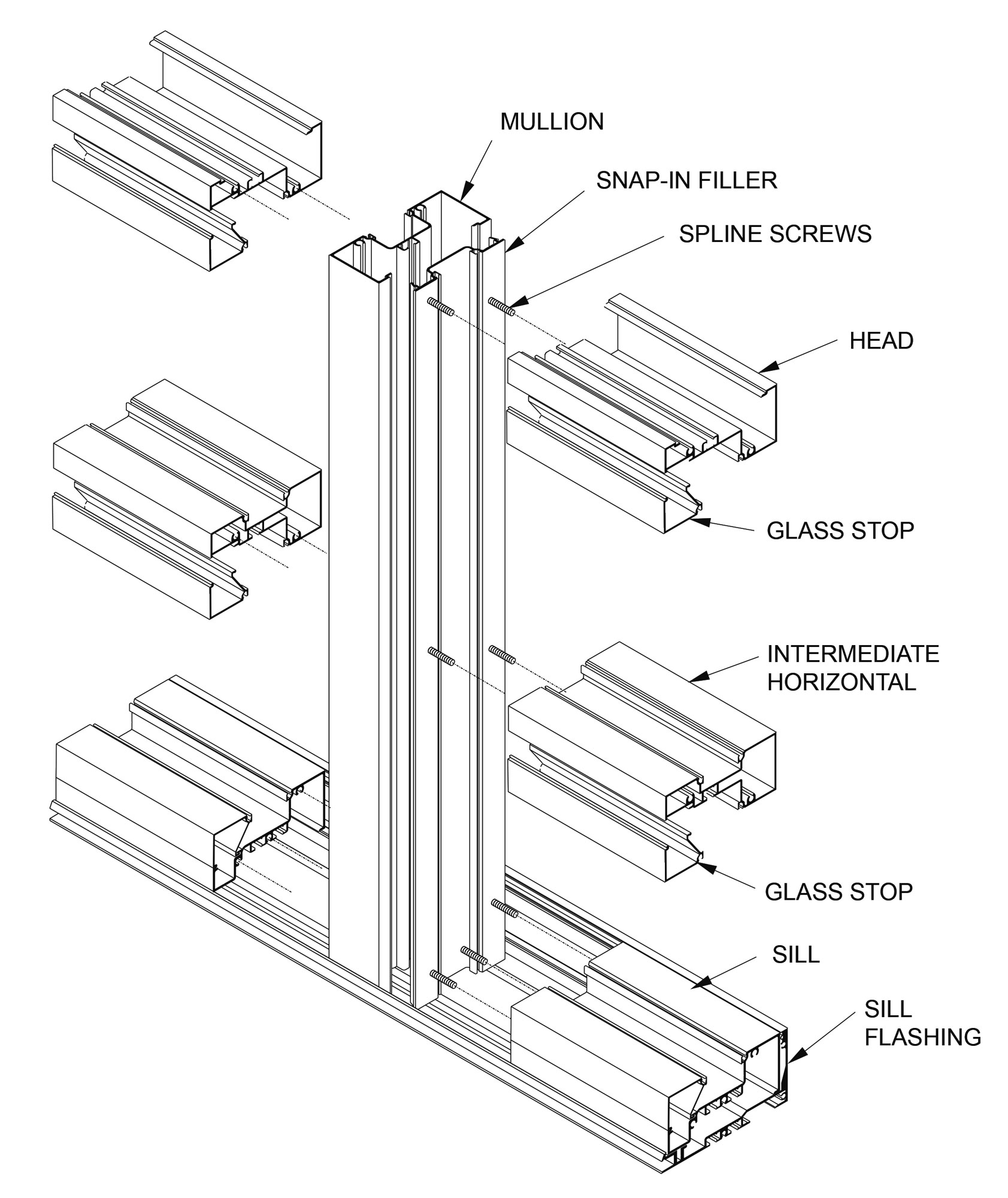
Image: Kawneer; courtesy of NGA
Screw Spline Method.
Screw Spline Method: The screw spline method involves using mating mullions during the fabrication process. Vertical mullions are designed in two sections so that horizontal members with integral screw races can be fastened with screws to each vertical half, forming a bay. Each bay is then snapped together during installation at the jobsite, with the screw heads not exposed in the final installation. This method is popular due to its ease of fabrication, assembly, and installation. To ensure proper water management, install water diverters at the intersections of the vertical jambs and horizontal members, and add end dams to the sill flashing to prevent water infiltration.
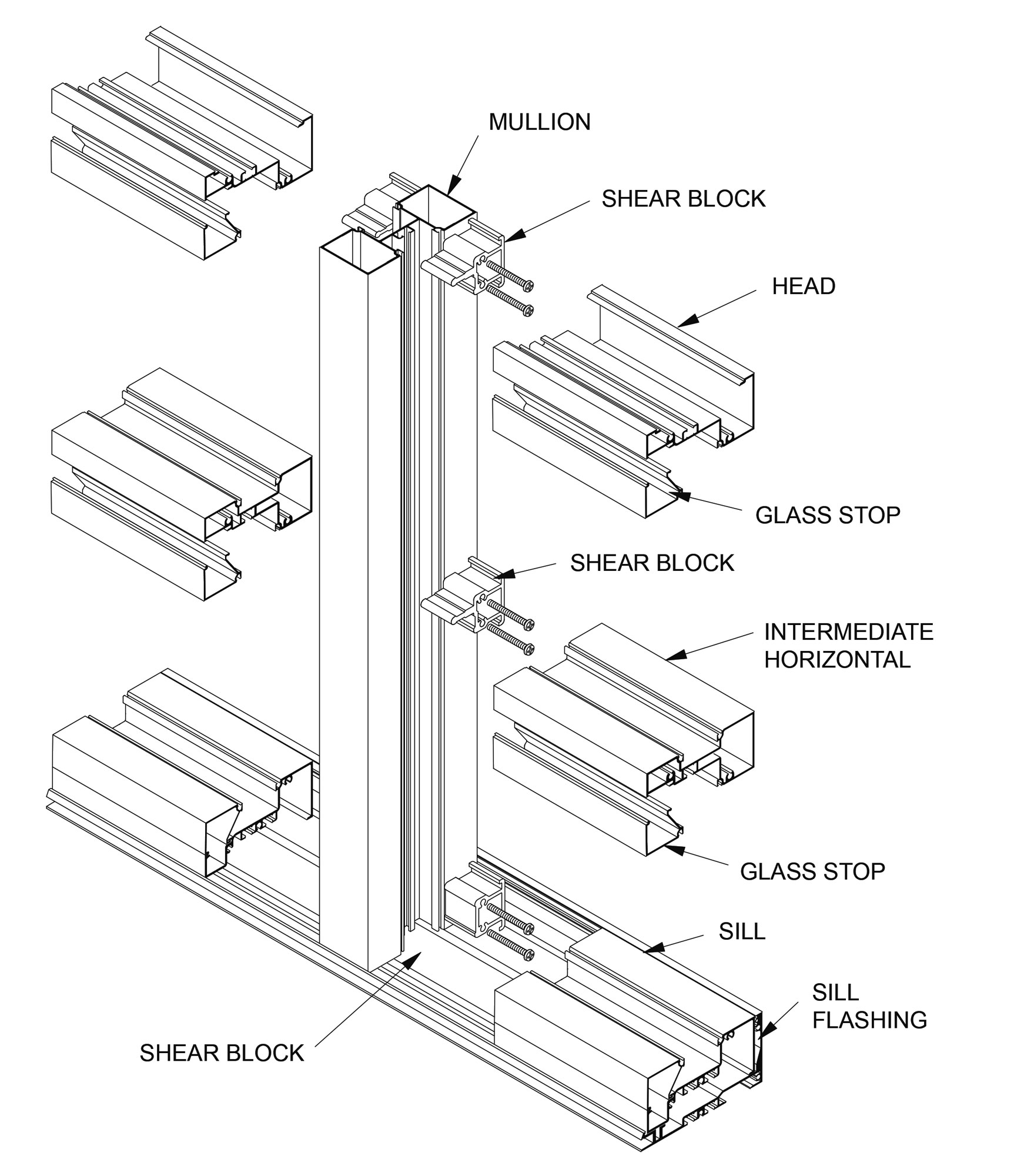
Image Kawneer; courtesy of NGA
Shear Block Method.
Shear Block Method: The shear block method, also known as the can system, is similar to stick curtain wall systems. In this method, horizontal members are attached to tubular vertical mullions that have screw-applied shear blocks. The horizontal members snap- or slip-fit over the shear blocks and fasten to them. Ensure that the horizontal locations are caulked at the shear block locations for a watertight seal, preventing water from penetrating the substrates and leaking into the building.
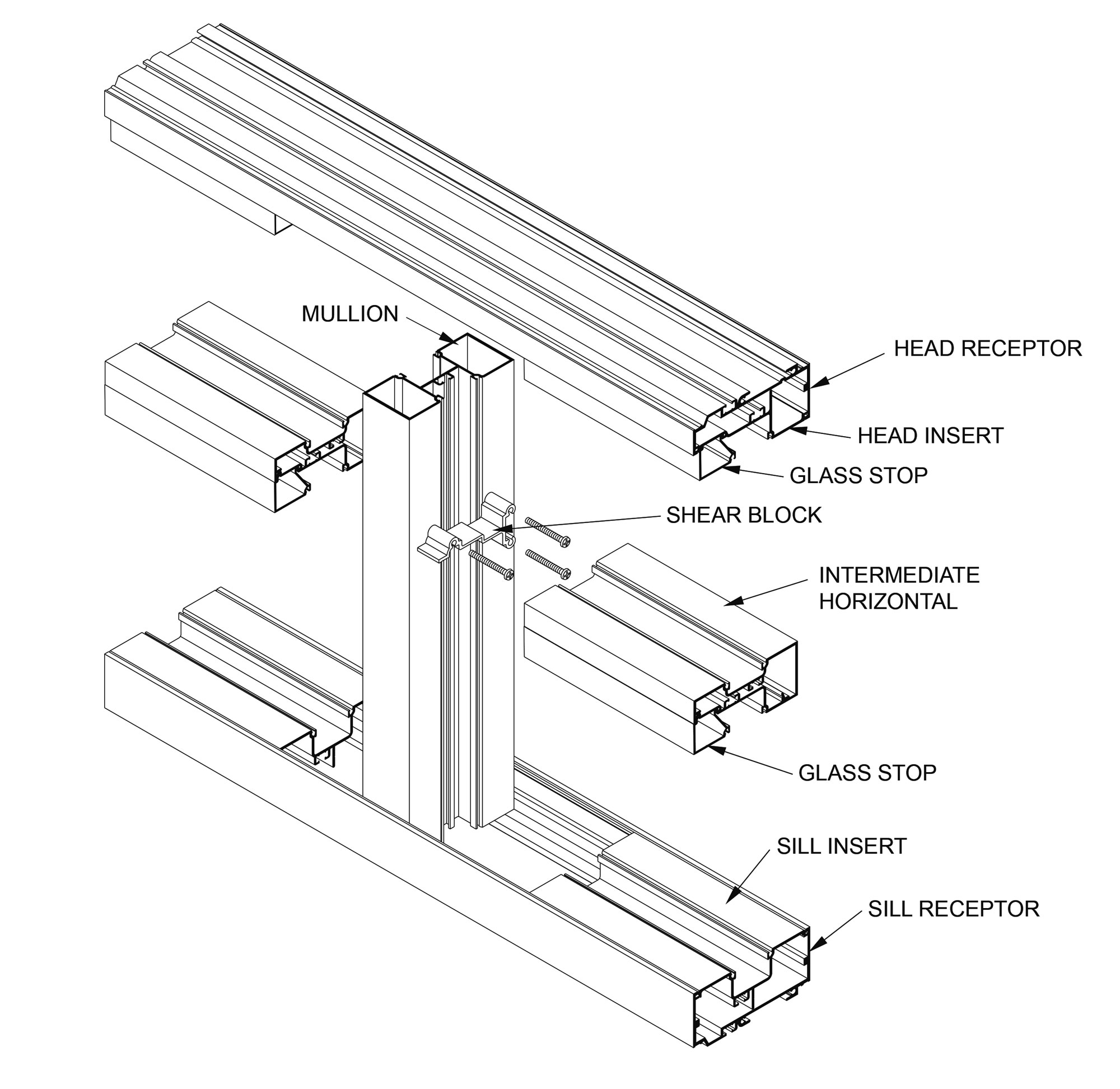
Image Kawneer; courtesy of NGA
Stacking Method.
Stacking: The easiest method of installation is a stacking storefront system which refers to the way it is assembled in an opening. Typically consisting of a continuous head and sill “gutter,” the vertical mullions are installed into the gutters and inserts cut to the daylight opening are then snapped into the gutters, holding the previous vertical in place. Each successive bay is stacked into position. Intermediate horizontals are usually attached to the vertical with shear blocks. Getting the details of installation correct is critical for the success of the project. "When designing exterior fenestration systems like storefront, window wall, and curtain wall, it’s critically important to specify exactly what you want and what you need. We always start with the required structural performance for the condition, says Billy Strait, vice president of business development for Oldcastle Building Envelope, a leading supplier of value-added, glazing-focused, interior and exterior products and services. “After that, we make recommendations based on the functional application and aesthetics. Without precise specification documentation, the contractor may bid something that misses the design and/or performance intent. There are many options with these products, so specifics are important."
Storefront window systems tend to be lower in cost per square foot than most other glazed framing systems because the overall requirements to withstand high pressure, water infiltration and thermal performance are generally less than other window systems. In general, storefront window systems are simpler and easier to install than more sophisticated window wall or curtain wall systems. Likewise, because structural requirements are less, the installer need not be as experienced, which provides some relief on installation costs. However, though installation may seem more straightforward, it is critical that storefront window systems be installed correctly to ensure the window performs as required, and special attention must be given to properly seal the internal joinery to control air and water infiltration within the system.
"When it comes to architectural design, the choice between storefront, window wall, and curtain wall systems hinges on the specific needs of the project,” says Joe Erb, National Accounts Manager for Quanex, a global, publicly traded manufacturer of building products that include insulating glass spacers, vinyl profiles, window and door screens, cabinet components, fenestration components, and vinyl extrusions. “Each system offers unique advantages, from the aesthetic appeal of a storefront to the robust protection of a curtain wall, and the balance of both with window wall. Know and understand the strengths and limitations of each system when specifying the envelope. The right choice will enhance both the functionality and beauty of the building."
Window Wall Systems
Window wall systems are an assembly of pre-glazed windows installed between floor slabs, making them suitable for mid-rise to high-rise residential and commercial buildings. This system spans between the floor slabs and is recessed from the slab edges or between spandrel construction of other glazing systems, such as precast concrete panels, metal panels, or masonry.
The windows are sometimes described as “ribbon” windows, as the long horizontal bands that are created can appear to be a ribbon around the perimeter of the façade. These systems provide a high degree of flexibility in design and can be adapted to various building configurations, from office spaces to hotels. Additionally, window walls allow for ample natural light, improving the indoor environment and reducing the need for artificial lighting.
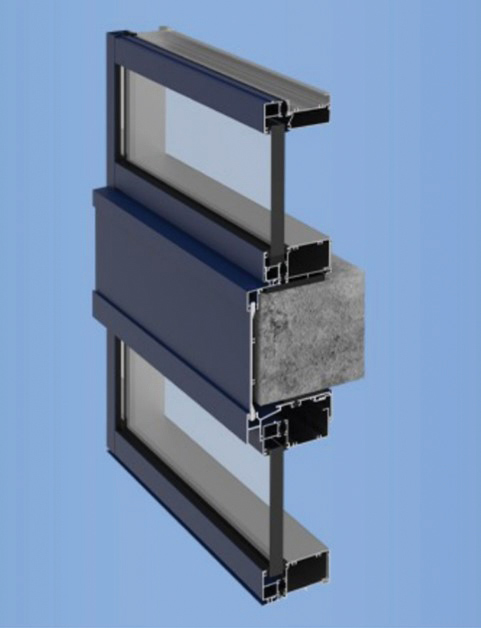
Photo: YKK; courtesy of NGA
This image shows the structure of a basic window wall glazing system.
History of Window Wall Glazing Systems
Early window wall systems were implemented to create bay windows and utilized face seals. Yet because of the single seal line at the exterior and the absence of a weep system, these early designs were particularly susceptible to air and water infiltration.
Modern window wall systems have advanced to include rainscreens and to span floor-to-floor with slab edge covers, providing water mitigation technologies designed to improve durability and reduce potential mold and sick building syndrome issues. In addition, concerns related to indoor environmental quality have been addressed through upgraded insulated glazing and airtight construction. These improvements support thermal comfort, energy efficiency, and also the acoustic performance of a building.
In general, modern window wall systems provide a good balance between cost and performance, making them a popular choice for many commercial applications. The building envelope reliability of the system is generally greater than that of a storefront system, though not necessarily as strong as that of a curtain wall system.
Performance Requirements of Window Wall Glazing Systems
Very similar to the performance standards required for storefront systems, window wall glazing systems also are evaluated according to:
- ASTM E283 (air infiltration),
- ASTM E330 (structural testing),
- ASTM E331 (static water infiltration),
- AAMA 1503 (U-factor and CRF testing) and
- NFRC 100 (U-factor),
- NFRC 200 (Solar Heat Gain Coefficient & Visible Transmittance) and
- NFRC 500 (Condensation Resistance)
In addition to this, because window walls are installed above the ground floor, they are also evaluated for seismic-related performance according to AAMA 501.4, and glazing fallout per AAMA 501.6.
AAMA 501.4 - Interstory Drift
AAMA 501.4 evaluates the performance of window wall systems under conditions of interstory drift, which occurs during seismic events. Interstory drift refers to the relative movement between floors in a building, a critical factor in high-rise structures where seismic activity can cause significant horizontal displacements. The test involves applying lateral displacement to the window wall system to simulate the expected interstory drift during an earthquake.
To succeed, the window wall system must pass criteria to demonstrate the ability to maintain structural integrity and functionality despite the induced movements.
Key criteria include:
- No glass breakage.
- No significant damage to framing members.
- Maintained ability to resist water and air infiltration.
AAMA 501.6 - Glazing Fallout
AAMA 501.6 addresses the potential for glazing fallout, which refers to the detachment of glass panels from the window wall system during seismic activities. This is a significant safety concern as falling glass can pose hazards to occupants and pedestrians. During the test, the window wall system is subjected to dynamic testing that replicates seismic forces, specifically focusing on the retention of glazing panels.
To pass the standard, the window wall must be able to maintain a secure attachment of glass panels so that none fall out during and after the simulated seismic event.
From a thermal performance perspective, a window wall may be either non-thermally broken, thermally improved, or thermally broken. This variable is largely dependent on the climate zone and thermal performance expectations of the project. Skipping thermal breaks is becoming less popular, in general, as concerns with building performance, energy costs, and operational carbon become more pressing. Thermal provisions may include thermoplastic clips separating the exterior face from the interior framing members, poured and de-bridged pockets, and mechanically crimped struts. As window wall systems are commonly implemented on low- to mid-rise buildings, today’s systems routinely meet static water infiltration requirements of 12-15 psf, notably higher than the standards set for storefront glazing systems.

Photo courtesy of NGA; TGP
The right fenestration system can greatly enhance the aesthetics of a project while also providing ample protection from the elements.
Fenestration systems for commercial buildings come in a wide range of types, styles, installation methods, budgets, and performance attributes. The variety available can pose a challenge to architects trying to keep up with the distinctions, advantages, and requirements of different systems. This article will provide a comprehensive overview of storefront, window wall, and curtain wall fenestration systems for commercial buildings. Each style has a very specific application and installation method, and appreciating the distinction between each is critical to ensure buildings are both aesthetically beautiful and help protect occupants from invasive air and water infiltration.
FENESTRATION SYSTEMS FOR COMMERCIAL BUILDINGS
Fenestration systems for commercial buildings encompass a wide range of types, styles, installation methods, budgets, and performance attributes. The variety available in the market poses a significant challenge to architects and builders, who must stay updated on the distinctions, advantages, and requirements of different fenestration systems. This article aims to provide a comprehensive overview of three primary fenestration systems used in commercial buildings: storefront, window wall, and curtain wall systems. Each system has specific applications and installation methods, and understanding these distinctions is vital for ensuring that buildings are both aesthetically pleasing to the public, and well-protected against air and water infiltration to safeguard the structure.

Photo courtesy of NGA
Storefront glazing systems are a favorite for the ground floor of commercial buildings, especially retail shops that want ample light and inviting interiors.
STOREFRONT SYSTEMS
A storefront glazing system is a fixed glazing system that is most commonly used on the ground floor of commercial buildings. They are designed to offer large, clear views, thereby enhancing visibility, letting ample natural light into the building, and providing inviting views to potential customers and passersby. These systems typically span one to two stories and are non-load-bearing, relying on the building structure for support. Storefronts are usually constructed from glass and aluminum frames, providing a modern and sleek appearance.
Storefront glazing systems accommodate glazing infills from ¼ inch to 1 inch in most applications and have profiles that closely mimic typical wall stud framing. The frames are anchored between the floor slabs, and the glass panels are installed within these frames. This method allows for quick and easy assembly, making it a popular choice for retail applications where time and budget constraints are required.
This fenestration is a basic, economical glazing system, often specified where minimum water and structural performance is required. The application of this design is primarily on visibility and accessibility. While they offer adequate protection against air and water infiltration, their performance in terms of thermal insulation and acoustic control is generally lower compared to more advanced systems like curtain walls. However, advancements in glazing technology have improved the thermal performance of storefront systems, making them more energy-efficient.
Many factors determine the proper application of a storefront glazing system. Among them are structural requirements, thermal performance, assembly method, water management, and glazing method.
History of Storefront Glazing Systems
Early storefront systems were composed of wood mullions with an applied sash to hold the glazing in place. As aluminum extrusions became more popular, these systems evolved into tubular framing members with screw applied stops on either side of the glazing infill. Older storefront systems used neoprene plug- or laced-in gaskets on one side of the glass with a wedge gasket on the other, which was placed once the glass was installed. The generic wedge-shaped profile, when installed, creates pressure that seats the glass against the other softer gasket, creating the line to stop air and water penetration.
Modern storefront evolved into a glazing system with integrated glass stops to give a “flush glazed” appearance, thus giving storefront the common name of “flush glazing.” Newer designs incorporate wedge-type gaskets used on both sides to facilitate ease of glazing and reduce the number of required parts. Modern storefront systems, unlike their predecessors, also have systems in place to control water infiltration and the means to evacuate moisture to the exterior.
Performance Requirements of Storefront Glazing Systems
Storefront glazing systems are evaluated and defined by a series of performance specifications from three organizations, the American Society for Testing and Materials (ASTM), the American Architectural Manufacturers Association (AAMA), and the National Fenestration Rating Council (NFRC).
The standards provided by these organizations provide a baseline evaluation methodology to ensure the fenestration system’s reliability, efficiency, and safety.
The primary standards used to assess storefront glazing systems include:
- ASTM E283 (air infiltration)
- ASTM E330 (structural testing)
- ASTM E331 (static water infiltration)
- AAMA 1503 (U-factor and Condensation Resistance Factor testing)
- NFRC 100 (U-factor)
- NFRC 200 (Solar Heat Gain Coefficient and Visible Transmittance)
- NFRC 500 (Condensation Resistance)
Testing for these standards is done in a controlled laboratory environment, and results are then provided to the manufacturers. It is important that architects have a strong working knowledge of the performance attributes of the glazing system to ensure the design, installation, and performance of the glazing system meets or exceeds both performance expectations and local building code requirements.
ASTM E283 - Air Infiltration: ASTM E283 measures the rate of air leakage through a storefront glazing system under specified pressure differences. This test is crucial for evaluating the airtightness of the system, which directly impacts energy efficiency and indoor air quality. By minimizing air infiltration, storefront systems help reduce heating and cooling loads, leading to lower energy consumption and improved thermal comfort. Additionally, a tight seal prevents the ingress of outdoor pollutants and allergens, enhancing the overall indoor environment and creating improved indoor air quality for occupants. The storefront system is subjected to a pressure differential, and the amount of air passing through the system is measured. The results are expressed in terms of air leakage rate, typically in cubic feet per minute per square foot (cfm/ft²) of the storefront area.
ASTM E330 - Structural Testing: ASTM E330 assesses the structural performance of storefront glazing systems under wind load conditions. This test applies both positive and negative pressures to the system to simulate wind forces that the building might encounter. The structural integrity of the storefront is evaluated to ensure it can resist these forces without experiencing excessive deflection, deformation, or failure. Storefront glazing systems are non-load bearing but must be designed and installed to properly support the glass and resist all applied loads, including wind pressure.
ASTM E331 - Static Water Infiltration: ASTM E331 evaluates the resistance of storefront glazing systems to water penetration under static pressure conditions. In this test, water is sprayed on the storefront at a uniform pressure to determine its ability to prevent water infiltration during typical rain events. Controlling water infiltration is vital for protecting the building’s interior from water damage and maintaining a dry and comfortable environment.
It is common practice to apply storefront glazing systems on the first floor of buildings. They are often set back from the most exterior plane of the roofing system to protect the storefront system from direct exposure to rain. These glazing systems are also often used in the first few floors of a building where water and structural performance are not as demanding as that which may be required on a high-rise, multi-span curtain wall system. Because of these constraints, storefront glazing systems need only meet static water infiltration requirements of 8 to 10 psf.
AAMA 1503 - U-Factor and Condensation Resistance Factor (CRF) Testing: AAMA 1503 evaluates the thermal performance of storefront glazing systems by measuring the U-factor and Condensation Resistance Factor (CRF). The U-factor indicates the rate of heat transfer through the storefront, with lower values representing better thermal insulation. CRF assesses the system’s ability to resist condensation formation on interior surfaces. Due to the shorter overall system depths of storefront glazing systems, U-factor and CRF performance will be generally less than that of deeper curtain wall systems.
As the focus on energy efficiency and thermal performance has increased over the past decade, new storefront systems are being designed with superior thermal performance and the incorporation of dual pour and de-bridge pockets, mechanically crimped thermal isolating struts, and in some cases the use of composite framing materials.
NFRC 100 - U-Factor: Similar to AAMA 1503, NFRC 100 involves measuring heat transfer through the storefront, and the results help determine the energy efficiency of the storefront system. NFRC 100 provides a standardized method for measuring the U-factor of storefront glazing systems, ensuring consistent and accurate thermal performance evaluations. Adherence to this standard is essential for energy codes and certification programs.
NFRC 200 - Solar Heat Gain Coefficient (SHGC) and Visible Transmittance (VT): NFRC 200 evaluates the Solar Heat Gain Coefficient (SHGC) and Visible Transmittance (VT) of storefront glazing systems. SHGC measures the amount of solar radiation transmitted through the storefront, which affects the cooling load and energy consumption. VT measures the amount of visible light transmitted, impacting daylighting and occupant comfort. Lower SHGC values are desirable for reducing cooling requirements, meaning the glazing performs better at blocking heat gain. By contrast, higher VT values indicate better natural lighting within the building.
Depending on the type of building and needs of occupants, specifying VT can provide a creative option to satisfy occupant requirements. When needed, lower VT ratings are better suited to reduce natural lighting to avoid glare, provide privacy, or create a specific aesthetic for the interior. For instance, spas, salons, and some restaurants may prefer less natural light.
NFRC 500 - Condensation Resistance: NFRC 500 assesses the condensation resistance of storefront glazing systems, ensuring they can maintain a dry and comfortable indoor environment. This standard evaluates the system’s ability to prevent moisture accumulation on interior surfaces, which is important for preserving indoor air quality and protecting building materials.
Structural Considerations for Storefront Glazing Systems
In some locations, storefront glazing must meet impact resistance requirements, such as those for hurricane-prone areas. This often involves the use of laminated glass and robust framing systems. Likewise, in earthquake-prone areas, storefront systems need to accommodate seismic forces. This may involve additional reinforcement and connections that allow for movement without compromising the integrity of the glazing.
Deflection criteria are specified to prevent excessive movement of the glazing system under load, which can affect performance and appearance. Typically, deflection limits are set to ensure the glazing does not displace excessively, which could cause sealant failure or glass breakage. Also, the design must account for the expansion and contraction of materials due to temperature changes. This can affect the framing and sealants, leading to potential issues with seal integrity and glazing stress.
Installation Guidelines for Storefront Glazing System
For most projects, a storefront glazing system is designed for optimal performance with applications having 4- to 5-foot spacing between vertical mullions with spans generally up to 10 to 12 feet. Manufacturers can provide guidance on exact limitations of glazing products, so it is important to engage the glazing manufacturer early in the design process.
System depth is usually between 4 inches and 6 inches, with system widths, often referred to as “sightlines,” varying between 1 ¾ inches and 2 inches. Due to the nature of the application, storefront glazing systems are not required to span large distances, so overall system depth can be smaller than that of a curtain wall system.
Thermal performance of a storefront glazing system is impacted by the type and style of glazing, installation methods, and thermal bridging. Depending on the climate zone and thermal performance requirements, a storefront system can be either non-thermal or thermally broken. The most typical thermal break method is a small pocket located somewhere in the middle of the extrusion filled with a polyurethane material and mechanically de-bridged to isolate the interior and exterior sections of the extrusion. This is commonly referred to as a “poured and de-bridged” thermal break.

Image courtesy of NGA
Here is an example of a storefront horizontal mullion with dual pour and de-bridge pockets (highlighted in green).

Image courtesy of NGA
Here is an example of a storefront horizontal mullion with mechanically crimped thermal isolating struts (highlighted in green).
Typically, a storefront glazing system is internally drained. This means that any water infiltration is captured in the horizontal member and diverted to the vertical and/or the sub-sill, where it weeps out of the system to the exterior. These systems are dependent on the quality of the internal seals to provide the lower water resistance they are designed to meet.
A storefront glazing is typically designed with three different assembly methods commonly known as screw spline, shear block, and stacking. Screw spline and shear blocking approaches enable glazing contractors to preassemble single units either in a shop environment or directly at the jobsite, while stacking happens on the jobsite. In all three methods, the vertical members typically run continuously while the head, horizontal, and sill members are attached between the verticals.

Image: Kawneer; courtesy of NGA
Screw Spline Method.
Screw Spline Method: The screw spline method involves using mating mullions during the fabrication process. Vertical mullions are designed in two sections so that horizontal members with integral screw races can be fastened with screws to each vertical half, forming a bay. Each bay is then snapped together during installation at the jobsite, with the screw heads not exposed in the final installation. This method is popular due to its ease of fabrication, assembly, and installation. To ensure proper water management, install water diverters at the intersections of the vertical jambs and horizontal members, and add end dams to the sill flashing to prevent water infiltration.

Image Kawneer; courtesy of NGA
Shear Block Method.
Shear Block Method: The shear block method, also known as the can system, is similar to stick curtain wall systems. In this method, horizontal members are attached to tubular vertical mullions that have screw-applied shear blocks. The horizontal members snap- or slip-fit over the shear blocks and fasten to them. Ensure that the horizontal locations are caulked at the shear block locations for a watertight seal, preventing water from penetrating the substrates and leaking into the building.

Image Kawneer; courtesy of NGA
Stacking Method.
Stacking: The easiest method of installation is a stacking storefront system which refers to the way it is assembled in an opening. Typically consisting of a continuous head and sill “gutter,” the vertical mullions are installed into the gutters and inserts cut to the daylight opening are then snapped into the gutters, holding the previous vertical in place. Each successive bay is stacked into position. Intermediate horizontals are usually attached to the vertical with shear blocks. Getting the details of installation correct is critical for the success of the project. "When designing exterior fenestration systems like storefront, window wall, and curtain wall, it’s critically important to specify exactly what you want and what you need. We always start with the required structural performance for the condition, says Billy Strait, vice president of business development for Oldcastle Building Envelope, a leading supplier of value-added, glazing-focused, interior and exterior products and services. “After that, we make recommendations based on the functional application and aesthetics. Without precise specification documentation, the contractor may bid something that misses the design and/or performance intent. There are many options with these products, so specifics are important."
Storefront window systems tend to be lower in cost per square foot than most other glazed framing systems because the overall requirements to withstand high pressure, water infiltration and thermal performance are generally less than other window systems. In general, storefront window systems are simpler and easier to install than more sophisticated window wall or curtain wall systems. Likewise, because structural requirements are less, the installer need not be as experienced, which provides some relief on installation costs. However, though installation may seem more straightforward, it is critical that storefront window systems be installed correctly to ensure the window performs as required, and special attention must be given to properly seal the internal joinery to control air and water infiltration within the system.
"When it comes to architectural design, the choice between storefront, window wall, and curtain wall systems hinges on the specific needs of the project,” says Joe Erb, National Accounts Manager for Quanex, a global, publicly traded manufacturer of building products that include insulating glass spacers, vinyl profiles, window and door screens, cabinet components, fenestration components, and vinyl extrusions. “Each system offers unique advantages, from the aesthetic appeal of a storefront to the robust protection of a curtain wall, and the balance of both with window wall. Know and understand the strengths and limitations of each system when specifying the envelope. The right choice will enhance both the functionality and beauty of the building."
Window Wall Systems
Window wall systems are an assembly of pre-glazed windows installed between floor slabs, making them suitable for mid-rise to high-rise residential and commercial buildings. This system spans between the floor slabs and is recessed from the slab edges or between spandrel construction of other glazing systems, such as precast concrete panels, metal panels, or masonry.
The windows are sometimes described as “ribbon” windows, as the long horizontal bands that are created can appear to be a ribbon around the perimeter of the façade. These systems provide a high degree of flexibility in design and can be adapted to various building configurations, from office spaces to hotels. Additionally, window walls allow for ample natural light, improving the indoor environment and reducing the need for artificial lighting.

Photo: YKK; courtesy of NGA
This image shows the structure of a basic window wall glazing system.
History of Window Wall Glazing Systems
Early window wall systems were implemented to create bay windows and utilized face seals. Yet because of the single seal line at the exterior and the absence of a weep system, these early designs were particularly susceptible to air and water infiltration.
Modern window wall systems have advanced to include rainscreens and to span floor-to-floor with slab edge covers, providing water mitigation technologies designed to improve durability and reduce potential mold and sick building syndrome issues. In addition, concerns related to indoor environmental quality have been addressed through upgraded insulated glazing and airtight construction. These improvements support thermal comfort, energy efficiency, and also the acoustic performance of a building.
In general, modern window wall systems provide a good balance between cost and performance, making them a popular choice for many commercial applications. The building envelope reliability of the system is generally greater than that of a storefront system, though not necessarily as strong as that of a curtain wall system.
Performance Requirements of Window Wall Glazing Systems
Very similar to the performance standards required for storefront systems, window wall glazing systems also are evaluated according to:
- ASTM E283 (air infiltration),
- ASTM E330 (structural testing),
- ASTM E331 (static water infiltration),
- AAMA 1503 (U-factor and CRF testing) and
- NFRC 100 (U-factor),
- NFRC 200 (Solar Heat Gain Coefficient & Visible Transmittance) and
- NFRC 500 (Condensation Resistance)
In addition to this, because window walls are installed above the ground floor, they are also evaluated for seismic-related performance according to AAMA 501.4, and glazing fallout per AAMA 501.6.
AAMA 501.4 - Interstory Drift
AAMA 501.4 evaluates the performance of window wall systems under conditions of interstory drift, which occurs during seismic events. Interstory drift refers to the relative movement between floors in a building, a critical factor in high-rise structures where seismic activity can cause significant horizontal displacements. The test involves applying lateral displacement to the window wall system to simulate the expected interstory drift during an earthquake.
To succeed, the window wall system must pass criteria to demonstrate the ability to maintain structural integrity and functionality despite the induced movements.
Key criteria include:
- No glass breakage.
- No significant damage to framing members.
- Maintained ability to resist water and air infiltration.
AAMA 501.6 - Glazing Fallout
AAMA 501.6 addresses the potential for glazing fallout, which refers to the detachment of glass panels from the window wall system during seismic activities. This is a significant safety concern as falling glass can pose hazards to occupants and pedestrians. During the test, the window wall system is subjected to dynamic testing that replicates seismic forces, specifically focusing on the retention of glazing panels.
To pass the standard, the window wall must be able to maintain a secure attachment of glass panels so that none fall out during and after the simulated seismic event.
From a thermal performance perspective, a window wall may be either non-thermally broken, thermally improved, or thermally broken. This variable is largely dependent on the climate zone and thermal performance expectations of the project. Skipping thermal breaks is becoming less popular, in general, as concerns with building performance, energy costs, and operational carbon become more pressing. Thermal provisions may include thermoplastic clips separating the exterior face from the interior framing members, poured and de-bridged pockets, and mechanically crimped struts. As window wall systems are commonly implemented on low- to mid-rise buildings, today’s systems routinely meet static water infiltration requirements of 12-15 psf, notably higher than the standards set for storefront glazing systems.
Window Wall Installation Methods
Window walls are installed from the interior of the building, which enhances safety and ease of installation, especially in high-rise construction. This method reduces the need for exterior scaffolding and minimizes disruption to the surrounding environment.
Window walls are typically designed either with the vertical members spanning the full frame height as in a storefront, or with the head and sill members continuous and vertical mullions spanning between the horizontals. Continuous head and sill member construction lend itself to optimal incidental water management, directing any water that might enter the system down the vertical members to weep out of the glazing system.
When the vertical members span the full frame height, assembly is accomplished much like a screw spline storefront system, in which each bay is snapped together and anchored to the surrounding condition. As mentioned, this approach may be faster and easier but does not support the best water management design.
A common disadvantage of continuous horizontal members is the need for a notch at the top of each vertical member, as necessary, to extend to the assembly surface of the head member. Head and sill members are typically spliced mid-lite for long elevations and anchored using a continuous anchor channel integrated into the sill member.
The structural requirements for window wall systems may be greater than those associated with storefront systems and less than those associated with curtain wall systems, with the mullion depths ranging accordingly. The size of the framing is determined based on the wind load, the span of the verticals, and the spacing between verticals. With portrait-oriented glazing panels, the vertical span of the frame will have a key influence on the required mullion cross-sectional dimensions.
The three main styles of window wall glazing systems are the stick system, unitized system, and panelized system.
Stick System: The stick system involves assembling the window wall components piece by piece on-site. Vertical mullions (sticks) are installed first, followed by the horizontal mullions and transoms. Glass panels and other infill materials are then installed into the assembled framework.
The stick system has several advantages. It allows for adjustments on-site, accommodating any last-minute design changes or site-specific conditions. Also, the components are transported individually, making it easier to handle logistics, especially for large projects.
On the other hand, this style of installation is very labor-intensive and requires on-site assembly, slowing down the construction schedule and increasing labor costs. Quality control can also be an issue as on-site fabrication is dependent on changing jobsite conditions, environmental conditions, and the skill level of the installation crew.
Unitized System: The unitized system consists of large panels pre-assembled in a factory setting, including framing and glazing. Glazing units are typically one or two stories tall and can span the full width of a building bay. Unitized systems tend to be more expensive to produce, but faster and less expensive to install than stick-style glazing systems. The prefabricated units are transported to the construction site and installed as complete sections. The system offers less flexibility for on-site adjustments but increases quality control for thermal, water, and air movement performance.
While factory-controlled conditions ensure consistent quality and precision in the assembly of units, transportation of such large units can be troublesome. The large units require careful handling and additional logistics during shipping and on the jobsite to unload and position the windows safely. This can snag daily construction schedules and potentially invite a costly mishap at the time of installation.
Panelized System: The panelized system is similar to the unitized system but involves larger panels that cover several floors or sections of the building. These panels are pre-assembled in the factory and then installed on-site.
One of the main advantages of panelized systems is performance expectations. The large units have fewer joints and connections compared to smaller unitized panels. As with most building systems, water, air, and thermal performance heavily depends on the quality of sealing joints, penetrations, and the area where two dissimilar materials meet. For panelized window wall systems, these transition areas are addressed in a controlled factory environment ensuring much higher standards of quality control.
Panelized systems are more difficult and challenging to transport than unitized window wall units due to their large size. The trade-off is that installation can go faster due to the size of the units. However, larger lifting devices like cranes will be required to position units for installation.

Photo: Wheaton & Sprague Engineering; courtesy of NGA
The curtain wall system at the William H. Gates Hall, University of Washington Law School, allows ample light into the building while providing a striking appearance on the exterior for students.
Curtain-Wall Systems
Curtain wall systems are non-load-bearing exterior walls that hang from the building’s structure like a curtain beyond the face of floor slabs, regardless of construction or cladding material. These systems can span multiple stories and are designed to withstand environmental forces such as wind and seismic activity. Usually, a curtain wall describes aluminum-framed systems supporting glass, panels, or louvers. However, steel, fiberglass, wood, composite, stone, and other products may also be incorporated into the system. This flexibility in material options makes curtain walls a highly attractive option for architects hoping to include unique or creative features in the design.
When properly designed, specified, and installed, curtain walls provide superior performance in terms of air and water infiltration, thermal insulation, and structural integrity. They are designed to accommodate building movements and resist environmental forces, ensuring long-term durability. The use of advanced glazing technologies and materials enhances the energy efficiency of curtain walls, making them suitable for high-performance buildings. However, these benefits come at a higher cost compared to storefront and window wall systems.
History of Curtain-Wall Glazing Systems
The concept of curtain walls can be traced back to the late 19th century during the Industrial Revolution. Early curtain walls were primarily constructed using cast iron and large glass panes. The Crystal Palace, designed by Joseph Paxton for the Great Exhibition of 1851 in London, is often cited as an early example of a curtain wall structure. It featured a cast-iron framework with large glass panels, showcasing the potential of using glass and metal in building exteriors.
Over time, cast iron was replaced by aluminum with its lightweight and corrosion-resistant qualities. Glazing technologies like insulating glass units (IGUs), double-glazed and triple-glazed units, along with low-emissivity (low-e) coatings helped enhance the energy efficiency and thermal performance of curtain walls. Today because of the performance attributes and aesthetic appeal, curtain walls are a popular choice for multistory buildings, especially high-rise urban construction.
Performance Advantages of Curtain-Wall Systems
Of the three glazing systems, curtain-wall systems offer the greatest opportunity for designing a high-performance building. While stick and window wall systems can satisfy code requirements and be enhanced to achieve greater thermal, acoustic, and structural performance, curtain-wall systems may be pre-loaded with these attributes.
Curtain walls are designed to span multiple floors and are anchored to the building’s structural frame. This design allows them to distribute wind loads and other environmental forces more effectively across the building structure. The strength of the anchorage also allows curtain wall systems to withstand seismic activity.
The anchorage schema helps reduce deflection from wind pressure, protecting vulnerable seals at joints and connections from excessive wear and tear. Overall, curtain walls have fewer points of access for water migration than stick-built and window wall systems. As noted earlier, the fewer joints and penetrations in the building envelope, the less the risk of water migration through faulty seams.
Installation Methods of Curtain-Wall Systems
Curtain wall installation is more complex than window wall systems but utilizes many of the same principles. Installation typically involves prefabricated units that are assembled on-site. As with window walls, curtain walls can be installed using stick systems or unitized systems. A third option, the hybrid system is also available. While unitized curtain-wall systems, also known as “cassettes” are factory built with glazing pre-installed, stick systems and sometimes hybrid curtain-wall systems require glazing installation on the jobsite.

Photo: Wheaton & Sprague Engineering; courtesy of NGA
Curtain wall systems are designed to offer large, clear views, thereby enhancing visibility, letting ample natural light into the building, and providing inviting views of the street.
Hybrid Curtain-Wall Installation
The hybrid system combines the benefits and basic installation elements of both the stick and unitized systems. It allows for some prefabrication while retaining flexibility for on-site adjustments. This method can be tailored to specific project needs, balancing cost, time, and performance considerations. Hybrid systems are very flexible and may or may not include the factory installation of infill and glazing materials.
Key components of the curtain wall, such as vertical mullions, horizontal transoms, and sometimes glazing units, are partially assembled in a controlled factory environment. This ensures high precision and quality control. The pre-assembled units or components are transported to the construction site and are typically smaller than fully unitized panels, making logistics and handling easier. On-site, the partially pre-assembled units are installed onto the building structure. The vertical mullions are first attached to the building’s structural frame, followed by the horizontal transoms.
If infill and glazing are not installed in the factory, glazing and other infill materials (like spandrel panels) are installed into the framework. This step may include sealing and weatherproofing to ensure the system’s integrity against air and water infiltration. In simple terms, the hybrid system creates a factory-built framework of exacting performance standards that is transported to the jobsite and secured to the structural components of the building. Once the frames are installed, glazing is installed. The connections and joints within the framework are already sealed, reducing the risk of water and air migration. Options on which type of fenestration system, styles, and installation methods can be challenging for architects and designers, which is why it is critical to keep pace with all the most recent developments and innovations.
Otto Ward, Architectural Design Manager and Business Development Manager for Garibaldi Glass understands the complexity of the current glass market. “Selecting between storefront, window wall, and curtain-wall fenestration systems has evolved from a relatively straightforward selection to a considerably more complex decision-making process, particularly with the introduction of more rigorous thermal and airtightness standards,” notes Ward. “To make an informed choice, it is essential not only to understand which systems are suitable for specific applications but also to assess their performance requirements. Utilizing thermal modeling will play a critical role in guiding the selection process and ensuring the chosen system meets the project’s specifications.”
Methods of Glazing Curtain-Wall Systems
There are four basic options available for installation of glazing in curtain-wall systems using stick or hybrid curtain-wall systems: captured glazing, structurally glazed, toggle-glazed, and point-supported. Each option offers advantages and drawbacks that range from structural integrity to aesthetic appeal.
Captured Glazing: Captured glazing involves securing the glass panels within a frame using mechanical fasteners, pressure plates, and gaskets to weatherproof and seal the unit. This method provides strong structural support and is widely used for its reliability and ease of installation.
After the grid framework has been installed─either via stick or hybrid system─glass panels are lifted and positioned into the frame and rest against interior gaskets within the mullions and transoms. The positioning of the glass is critical to ensure it aligns properly and maintains the intended design.
Once in position, pressure plates are placed on the exterior side of the mullions and transoms, over the edges of the glass panels. These plates are fastened with screws, applying uniform pressure to hold the glass firmly in place. Gaskets are installed around the glass edges to create a weather-tight seal, and additional sealant may be applied to enhance waterproofing and prevent air infiltration. This method offers strong structural support and reliable sealing, making it suitable for high-performance curtain wall applications.
Structurally Glazed: In structurally glazed systems, the glass panels are bonded to the frame using high-strength structural silicone sealants, eliminating the need for pressure plates and creating a smooth, uninterrupted glass surface. This method allows for larger glass panels but requires precise fabrication and installation to ensure structural integrity and performance.
Vertical mullions and horizontal transoms are installed to form the structural framework of the curtain wall. This can be either stick-built or a hybrid system. Glass panels are placed against the interior side of the frame allowing for installation within the building and reducing the need for scaffolding and cranes. The structural silicone sealant is applied to bond the glass to the mullions and transoms and provides the necessary structural support and weatherproofing. Additional sealant is applied to ensure airtight and watertight seals around the glass edges, and spacer blocks are used to maintain consistent joint widths and ensure proper adhesion.

Photo courtesy of NGA
Because of the rapidly changing technologies available for storefront, curtain wall, and window wall systems, architects are well advised to keep current on recent trends.
Toggle-Glazed: Toggle-glazed systems use a toggle mechanism to secure the glass panels to the frame. This method combines the benefits of captured and structurally glazed systems, providing a clean appearance with strong structural support. Toggle-glazed systems are gaining popularity for their ease of installation and maintenance.
Vertical mullions and horizontal transoms are installed, featuring grooves or channels to accommodate the toggle mechanism. The framework, usually a hybrid system, is designed to receive glass panels with minimal visible hardware.
Glass panels, often pre-fabricated with a toggle gasket or insert, are placed against the frame. Toggles, which are mechanical clips, are inserted into the frame’s grooves, securing the glass from the inside. Once the glass and clips are in place, the toggles lock the glass panels in place, ensuring they are firmly attached to the frame. Additional seals and gaskets may be applied to enhance weatherproofing.
The toggle-glazed style of installation can provide enhanced protection for the building against water and air intrusion because it incorporates both mechanical- and captured-glazed style adhesives. Another benefit of the toggle system is that if an individual glass panel needs to be replaced, it can be removed and reinstalled without disrupting adjacent panels. This provides easier maintenance for the building owner over the life of the building and is especially helpful in areas of extreme wind and weather events, where glazing may be damaged by airborne projectiles.
Point-Supported: Point-supported systems use a series of metal fittings (spiders) to hold the glass panels in place at specific points. This method allows for maximum transparency and minimal visual obstruction, making it ideal for applications where aesthetics are a primary concern. Point-supported systems require precise engineering to ensure load distribution and structural stability.
A primary structural framework often made of steel or aluminum is installed to support the point fixings. Spider fittings or other point-support mechanisms are attached to the structure at pre-determined points.
Glass panels are fabricated with pre-drilled holes at specific locations to accommodate the point supports. The glass is lifted and positioned so that the holes align with the point supports. Once in position, bolts or other hardware used to attach the glass panels to the point supports. Gaskets or other sealing materials are used to ensure a weather-tight connection around the points.
The point-supported glazing system allows for large, uninterrupted surfaces that can offer striking design aesthetics. The minimal interruption provides maximum daylighting for the building interior, which can help with biophilic design goals and reduce energy use of artificial lighting.
Some of the drawbacks to point-supported systems include cost. This style of installation can be more cost-prohibitive than captured or toggle glazed systems. Also, correct alignment and drilling of the glass panels is critical for a successful installation with little margin of error. To this point, the holes in the glass need to be considered basic penetrations in the building envelope, so sealing around each point-support is critical.
Conclusion
Given the wide range of commercial fenestration options available, projects are best served by architects and designers who understand the types, limitations, and basic installation processes for storefront, window wall, and curtain-wall glazing systems.
Storefront systems offer an economical and visually appealing solution for ground-level applications, providing clear views and easy access, albeit with moderate performance in thermal and acoustic insulation. On the other hand, window wall systems bridge the gap between cost and performance, making them suitable for mid-rise to high-rise applications where enhanced thermal and acoustic properties are desired. Finally, curtain-wall systems stand out for their superior performance and versatility, capable of withstanding environmental forces while delivering a sleek, modern facade.
Understanding these distinctions helps architects and builders select the appropriate system to meet specific project requirements, ensuring that buildings are not only visually compelling but also energy-efficient, resilient, and comfortable for occupants.
Andrew A.Hunt is Vice President of Confluence Communications and specializes in writing, design, and production of articles and presentations related to sustainable design in the built environment. In addition to instructional design, writing, and project management, Andrew is an accomplished musician and voice-over actor, providing score and narration for both the entertainment and education arena. www.confluencec.com, www.linkedin.com <






















